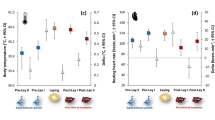Summary
-
1.
A method is described for determining the temperature of fertile and infertile eggs of the African Ostrich, the absolute humidity of the nest and ambient air during 41 days of incubation without recourse to direct thermometry or relative humidity sensor. These values are calculated from weekly determinations of mass changes of a diffusion hygrometer made from an ostrich eggshell, and eggs in the nest, some of whose shell conductance to water vapor had been previously established.
-
2.
During the incubation period the absolute nest humidity remained relatively constant at a mean value of 13.2 Torr and is maintained 4.7 Torr above the ambient humidity. The saturation water vapor pressure of fertile (but not of infertile) eggs gradually increases from 41 to 47 Torr because of the rise in egg temperature from 34.5 to 37.1°C at the end of incubation. Infertile eggs remain at 35.0°C.
-
3.
Because of the increase in saturation vapor pressure of fertile eggs during the last half of incubation, the water vapor pressure difference between the egg and the nest air increases. This change accounts for the proportional change in egg water loss which increases from 4.3 to 5.0 g d−1 at the end of 41 days.
Similar content being viewed by others
References
Andersen Ø, Steen JB (1986) Water economy in bird nests. J Comp Physiol B 156:823–828
Ar A, Paganelli CV, Reeves RB, Greene DG, Rahn H (1974) The avian egg: Water vapor conductance, shell thickness and functional pore area. Condon 76:153–158
Ar A, Rahn H (1980) Water in the avian egg: overall budget of incubation. Am Zool 20:373–384
Bligh J, Hartley TC (1965) The deep body temperature of an unrestrained ostrichStruthio camelus recorded continuously by a radiotelemetric technique. Am Zool 107:104–105
Brown WY (1976) Egg specific gravity and incubation in the Sooty Tern and Brown Noddy. Auk 93:371–374
Chattock, AP (1925) On the physics of incubation. Phil Trans R Soc London Ser B 213:397–450
Drent R (1970) Functional aspects of incubation in the Herring Gull. Behaviour [Suppl] 17:1–132
Grant GS, Pettit TN, Rahn H, Whittow GC, Paganelli CV (1982) Water loss from Laysan and Black-footed Albatross eggs. Physiol Zool 55:405–414
Paganelli CV (1980) The physics of gas exchange across the avian eggshell. Am Zool 20:329–338
Piiper J, Dejours P, Haab P, Rahn H (1971) Concepts and basic quantities in gas exchange physiology. Respir Physiol 13:292–304
Rahn H (1984) Factors controlling the rate of incubation water loss in bird eggs. In: Seymour RS (ed) Respiration and metabolism of embryonic vertebrates. Martinus Nijhoff/Dr. W. Junk, The Hague, pp 271–288
Rahn H, Ackerman RA, Paganelli CV (1977) Humidity in the avian nest and egg water loss during incubation. Physiol Zool 50:269–283
Rahn H, Dawson WR (1979) Incubation water loss in eggs of Heermann's and Western Gulls. Physiol Zool 52:451–460
Rahn H, Hammel HT (1982) Incubation water loss, shell conductance, and pore dimensions in Adelie Penguin eggs. Polar Biol 1:91–97
Rahn H, Krog J, Mehlum F (1983) Microclimate of the nest and egg water loss of the EiderSomateria mollissima and other water fowl in Spitsbergen. Polar Res 1:171–183
Spotila JR, Weinheimer CJ, Paganelli CV (1981) Shell resistance and evaporative water loss from bird eggs: effects of wind speed and egg size. Physiol Zool 54:195–202
Swart D, Rahn H, de Kock J (1987) Nest microclimate and incubation water loss of eggs of the African Ostrich (Struthio camelus var.domesticus). J Exp Zool [Suppl] 1:239–246
Tullett SG (1981) Theoretical and practical aspects of eggshell porosity. Turkey 29:24–28
Walsberg GE (1983) A test for regulation of nest humidity in two bird species. Physiol Zool 56:231–235
Author information
Authors and Affiliations
Additional information
This paper is part of a Ph.D. (Agric) thesis submitted by the first author to the University of Stellenbosch under Prof. J.P. Hayes as promoter.
Rights and permissions
About this article
Cite this article
Swart, D., Rahn, H. Microclimate of ostrich nests: measurements of egg temperature and nest humidity using egg hygrometers. J Comp Physiol B 157, 845–853 (1988). https://doi.org/10.1007/BF00691017
Accepted:
Issue Date:
DOI: https://doi.org/10.1007/BF00691017




